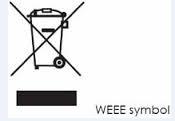Guest blog by Carolyn Couch, Waste & Recycling Manager at the University
When I mention WEEE I sometimes get a strange look from those that are not involved in managing waste. However it is becoming better known that WEEE is the acronym for Waste Electrical and Electronic Equipment (WEEE) and that there are laws to ensure we manage this waste to prevent harm to the environment and for health and safety reasons. In a nutshell WEEE is any item that you no longer want which has a plug or a battery. 
Ever noticed a diagram on a product of a wheelie bin with a cross through it ? This is an indication that you must ensure that it is separately collected and treated so that we comply with the law.
In 2013/14 the university created over 56 tonnes of WEEE. In line with the Waste Hierarchy we want to reduce the amount of this waste we create, and consider repairs before reuse and recycling. However it is inevitable that we will still have a constant stream of these materials to dispose of. The products are wide ranging and some contain hazardous materials including lead, cadmium and mercury, which is why it is also important to comply with regulations.
So what happens to the University’s WEEE?
We aim to ensure our contractors utilise materials for reuse and recycling where possible but a priority for any university is that responsible data erasure is also carried out. The University currently uses a contractor called EOL IT Services, based in Essex and I recently visited their processing facility to see first hand how our WEEE is managed.
The journey starts when the EOL collection van arrives and our Waste & Recycling supervisor oversees this collection process, the materials are then taken to the EOL processing facility. On arrival the van is unloaded and each piece of equipment is given an individual barcode so it can be easily tracked through the process. The item is then weighed, categorised and verified. Items are categorised into A Grade (Complete, Fully Working and Cosmetically Good Condition), B Grade (Incomplete, Parts Missing and Repairable) and C Grade (Broken, Unable to Test and Bad Condition (Beyond Economical Repair). Any data bearing items would be transferred to a secure area of the warehouse and Wiped to Infosec Level 5 – Enhanced Standard and any hard drives deemed faulty would be physically destroyed. Damaged or broken equipment is evaluated to determine if there are parts that can be reused such as keyboards and memory cards. If an item is beyond repair ferrous and non-ferrous metals and other recyclable materials are separated into bays and hazardous materials are collected by a re-processor who specialises in refining and managing these materials. The turn around for reusable items can be quick with minor repairs fixed at a workshop within the processing facility and can be resold to EOL customers within 3 days!
It is reassuring to know that the University’s WEEE contractor endeavours to adhere to a zero landfill policy, complies with legislative needs and works with a number of charities and education facilities. This gives us the satisfaction that our management of WEEE meets a high standard through our own and the contractor’s own audits to meet ISO14001 standards which ensure risks are monitored and processes continually improve.